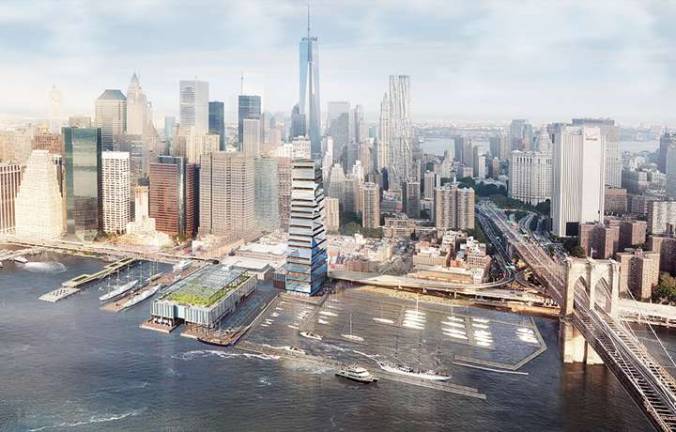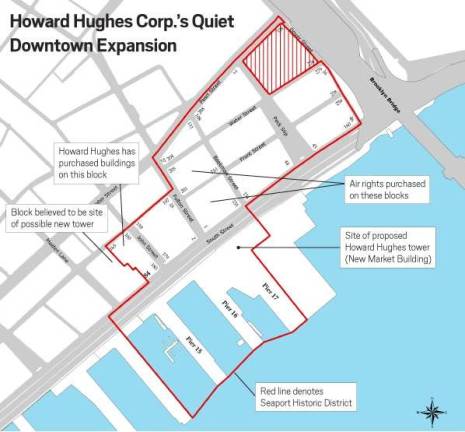Howard Hughes’ Quiet Expansion


The main community group opposed to the Howard Hughes Corp.’s redevelopment plans for the South Street Seaport Historic District revealed that the company has acquired several pieces of property adjacent to the district, which may eventually be proposed as an alternative location for a 42-story residential tower the developer has been trying to build on the Seaport.
Save Our Seaport, a community group that describes itself as defenders of the historic district, obtained a letter Howard Hughes sent to shareholders dated March 13. The letter disclosed the company’s acquisition of at least seven properties, including a parking lot, adjacent to the historic district. The acquisitions also include hundreds of thousands of square feet in air rights and were all made in the last six months, according to SOS.
David Sheldon, a spokesperson for Save Our Seaport, said the shareholder letter indicated that the acquisitions were part of the same assemblage, but did not say whether the site would be proposed as an alternative location for the tower.
Although the company hasn’t formally announced its intentions, members of Save Our Seaport are inclined to think it will eventually be proposed as an alternative location for Howard Hughes’ residential tower.
“That’s our thinking, certainly,” said Sheldon. “They haven’t indicated to us that they’re building a giant tower there. They have, however, purchased the air rights to enable them to do so.”
Howard Hughes, through a spokesperson, declined to comment.
All told, the recently acquired properties and air rights represent 818,000 square feet of buildable space just outside the historic district’s southeastern boundary, according to SOS. The parcel is on a square block bounded by South Street and Maiden Lane to the south and east, and Front Street and John Street to the west and north.
If Howard Hughes were to build a tower on the newly acquired assemblage site, it could wind up being taller than 1 World Trade Center, according to SOS. “The Howard Hughes Corporation has been busily assembling properties on the immediate outskirts of the South Street Seaport Historic District that may allow them to build the largest residential mixed use building in North America ‘as of right,’” said Sheldon in an SOS press release.
The Texas-based developer has been seeking to build a 42-story residential building on the current New Market Building site in the Seaport Historic District since early last year. That plan has run up against strong resistance from the community and elected officials, who believe such a tower would be out of place in the historic district.
Howard Hughes officials have claimed they need to build a tower on the New Market Building site in order to pay for the rehabilitation of the district as well as $300 million in community benefits they’re proposing to build, such as a middle school and an affordable housing project.
The company’s project stalled in February, despite the $300 million amenity package, after Council Member Margaret Chin and Manhattan Borough President Gale Brewer expressed criticism about the 494-foot luxury tower being located at the New Market Building site.
Chin and Brewer came out against the plan after months of negotiation between Howard Hughes and the Seaport Working Group, a coalition of residents, community groups and elected officials with interests in the Seaport.
Howard Hughes, which had representatives in the Seaport Working Group, nevertheless decided to go against one of the group’s main recommendations last spring that “alternatives to the proposed 50-story tower should be sought and any building on the New Market site should be contextual with the buildings within the South Street Historic District.”
In November, the company presented a revised plan with a tower on the same site that was just 10 stories shorter, which prompted the criticism from Chin and Brewer and left the project in a sort of limbo for the last five months.
According to SOS, Howard Hughes began buying up property and air rights in October of last year, one month before revealing the Seaport tower proposal with ten fewer stories.
Michael Kramer, a member of Save Our Seaport and the now-disbanded Seaport Working Group, said the community asked Howard Hughes to find an alternative site, and that it seems the company “certainly took on this task with Texas-sized enthusiasm, assembling properties that were merely adjacent to the low-rise 19th Century Seaport buildings.”
Sheldon stopped just short of calling this latest development a victory for the community, and said much remains to be seen as to what Howard Hughes will propose to do with their massive assemblage.
“I think it’s really too soon to say if this is a win for the community,” said Sheldon. “We haven’t seen the shape of this tower yet…and we don’t know what the load on the community infrastructure will be as opposed to what it will offer.”
As for the Seaport, the only way a tower on Howard Hughes’ new assemblage site will infringe on the historic district is in the form shadows it will cast.
“Would it be something of a win? Certainly it’s a win for the Seaport, it’s a win for the waterfront,” said Sheldon. “But if the tower is being relocated it raises other questions.”
Sheldon added that the community is now waiting to see how this latest development “impacts the rest of the plans for the Seaport.”